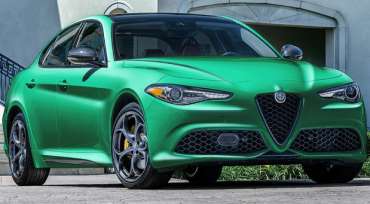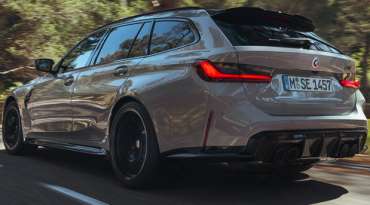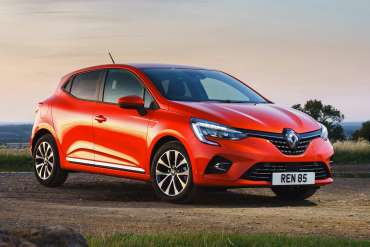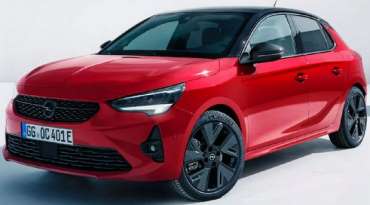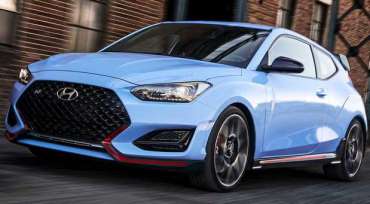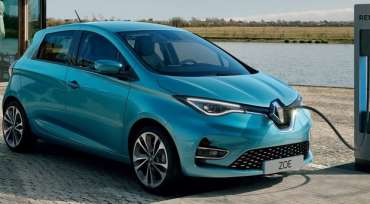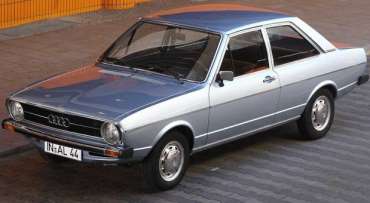
World Car Blog
Alfa Romeo Giulia Special
Alfa Romeo has offered a special edition of Giulia in the Canadian market, model year 2022. It is Giulia Speciale, in a series limited to only 15 copies.
The car immediately attracts attention with its exclusive "Verde Montreal" color, which Alfa Romeo previously offered only on its Quadrifoglio models.
This Giulia is based on the standard Veloce version with all-wheel drive, but is equipped with the same Alfa adaptive suspension as the Quadrifoglio. This suspension system reads the way and is currently adjusting to improve management. The system works differently depending on the selected driving mode. There is also a limited slip differential.
The Alfa Romeo Giulia Speciale also comes with black exterior markings, a carbon fiber scudetto mask and carbon fiber mirror covers. There are also 19-inch dark wheels, yellow brake calipers and carbon-fiber sills.
Inside are carbon fiber details, black leather sports seats, Harman Cardon audio system, as well as a control panel, steering wheel, central armrest, gear lever and door top panels with red contrasting stitching.
Under the hood is a 2.0-liter four-cylinder turbo engine with 280HP and 415 Nm of torque, paired with an eight-speed automatic transmission, while acceleration from 0 to 100 km / h is 5.1 seconds.
Prices for this Giulia in Canada start from 71,995 dollars there, which is 52,800 euros.
BMW M3 Touring and officially
At this year's edition of the Goodwood Festival of Speed (2022 Goodwood Festival Of Speed, June 23-26), BMW Motorsport will celebrate its 50th anniversary, among other things, with the promotion of the new M model.
It is the premiere of the long-awaited sports caravan M3 Touring, internal designation G81.
However, BMW showed M3 Touring to the press even before the mentioned event in Goodwood, so there are no more secrets.
So, the M3 Touring will be powered by a 3.0-liter twin-turbo six-cylinder engine with 375 kW / 510 hp and 650 Nm of torque.
The engine is paired with an 8-speed dual-clutch automatic transmission, with xDrive all-wheel drive.
Acceleration from 0 to 100 km / h takes 3.6 seconds (0.1 s slower than the M3 sedan), reaches 200 km / h in 12.9 seconds and can reach el. limited to 250 km / h. With the optional M Driver’s Package, top speed is 280
Carbon-ceramic brakes will also be offered as an option.
With 4794 mm, the M3 Touring is 85 mm longer than the standard 3 Series Touring, 76 mm wider (1903 mm) and 4 mm lower (1436 mm). Here is the fact that the volume of the trunk ranges from 500 to 1510 liters.
As for the wheels, they are 19 and 20 inches, with 275/35 ZR19 and 285/30 ZR20 tires.
The package for the new M3 Touring also includes the M aero body kit (modified front bumper with larger air vents, wider fenders, a set of more striking sills, rear diffuser, rear roof spoiler ...), hood with air vents, sports suspension, sports exhaust system with four exhaust pipes, sports seats and M steering wheel, 12.3-inch digital instrument panel and 14.9-inch touch screen ...
The car will also have the most advanced traction and stability control systems.
It should be reminded that this sports caravan set its first official record a few days ago.
Specifically, the M3 Touring crossed the Nürburgring in 7: 35,060 minutes, making it the fastest production wagon on that track.
Finally, the price: M3 Touring in Germany costs 97,800 euros.
Used Renault Clio (Mk5, 2019-date) review
Verdict
It's more than three decades since the Clio burst onto the scene, advertised in the famous Nicole and Papa TV adverts. Since then, Renault's stylish supermini has matured superbly, and while it isn’t quite as small as it used to be (the Clio Mk5 is 30cm longer and 16cm wider than the original), that just makes it more usable, while still being small enough to be easy to park and agile to drive. Not only did our sister brand Carbuyer make the Clio its Car of the Year in its 2020 New Car Awards, it followed up with the Best Small Car crown in 2021. The same year Auto Express announced that the Clio was its Supermini of the Year in its New Car Awards ceremony. On the downside, Clio prices have risen over the past few years, because while this is a small car, it still features a lot of tech. However, the Clio's rivals are more expensive too, and if you're looking for a really good supermini-sized all-rounder, the Clio should be on your shortlist.
Renault made its first car at the end of the 19th century, and since then it has built a reputation for creating some great cars, most of which have been small. Of course this French company has tried its hand at cars of all sizes, but it's models such as the 4CV, R4 and R5 that have made some of the biggest waves. To that list the Clio can be added. Since its debut in 1990, this chic small car has become a best seller for its maker, thanks in no small part to its attractive pricing, low running costs, smart styling and keen value.
Things took a big jump in the right direction with the arrival of the fourth-generation Clio in 2013, because that's when Renault increased the size and it also made big strides in terms of quality. So when the Clio Mk5 arrived six years later, it was no surprise that on the outside Renault didn't make big changes. But inside the Clio was much more grown up and quality was further improved, making it the most appealing edition yet.
History
The first examples of the Clio Mk5 were delivered in October 2019. The range started with the 71bhp non-turbo 1.0-litre SCe 75, while there was also a turbocharged version of this three-cylinder engine available, in the 99bhp TCe 100. For those who wanted a bit more poke the range was topped off with a 1.3-litre four-cylinder engine in the 128bhp TCe 130. Buyers with more of a focus on economy could choose the Blue dCi 85 with an 84bhp 1.5-litre diesel engine.
A year after the Clio arrived, in October 2020, Renault introduced a hybrid version of the Clio called the E-Tech. Whereas the Captur SUV and Megane hatchback E-tech models featured plug-in capability, this didn't feature on the Clio, so its electric-only range was much less. The Clio E-Tech was powered by a 1.6-litre petrol engine backed up by an electric motor to give 138bhp, making it the most powerful model in the range. The Clio E-Tech was fitted with a 1.2kWh battery pack and this powertrain was offered with all of the standard trims: Play, Iconic, S Edition and R.S. Line.
Which one should I buy?
Gone are the days of having to choose how many doors your Clio comes with; all of them come exclusively with five. So it's just a question of choosing the best engine for your needs, and in reality it's going to be a TCe unit, or the E-tech hybrid, because the SCe and dCi engines are rare and offer few advantages. If you do lots of urban driving the E-Tech is probably your best bet, but if you do mainly longer journeys, a TCe powerplant will probably be more frugal as well as cheaper to buy in the first place.
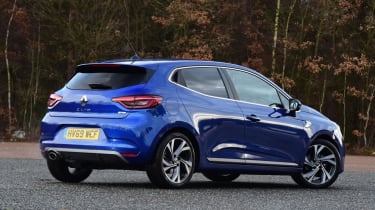
Even the entry-level Clio Play isn't spartan; it features air-con, LED headlights, a DAB radio, Bluetooth and electric front windows, along with 16-inch steel wheels. To this the Iconic adds 16-inch alloys, privacy glass, rear parking sensors, keyless go and a seven-inch touch-screen display. Powered rear windows came in from the S Edition, which also featured climate control, a 9.3-inch display, automatic headlights and wipers, 17-inch alloys and a shark fin antenna. The R.S. Line sat at the top of the Clio range and this came with a rear parking camera as well as front parking sensors, 17-inch wheels, sportier styling inside and out, plus selectable drive modes.
Alternatives to the Renault Clio Mk5
Just about every mainstream car maker offers at least one supermini, so you really are spoiled for choice in this segment. Our pick of the bunch is the Ford Fiesta, which is as close to the ideal used supermini as you'll find. It's readily available, there's a wide model range, prices are keen and the Fiesta is also great fun to drive. Build quality and reliability are good, equipment levels tend to be generous, and practicality is also impressive.
The Vauxhall Corsa ticks most of the same boxes as the Fiesta, with plenty of them to choose from, lots of engine and trim level combinations, a decently roomy cabin and low running costs. But the Vauxhall can't match the Ford's dynamic prowess. The Corsa is related to the Peugeot 208 which is why both of them come in electric form, although there are petrol editions available too. The Peugeot offers reasonable value and it looks superb, but in electric form both the Corsa and the 208 are costly to buy, if not to run.
If going full electric seems like a step too far, the petrol-electric hybrid Toyota Yaris might suit you better. powertrain. Economical and stylish, the Toyota is also very reliable and well equipped. While running costs are low, purchase prices are high and a small boot limits practicality, but the Yaris is still a worthy contender.
Another brilliant all-rounder is the SEAT Ibiza, which looks sharp, is well equipped, good to drive and there are plenty to choose from on the used market. Closely related to the SEAT are the Volkswagen Polo and Skoda Fabia, which sit on either side of the Ibiza in terms of price and value. Whereas the VW is more upmarket, the Skoda gives you more for your money, but it's no poor relation with its efficient engines and (usually) generous equipment levels.
Two cars that are closely related to each other are the Hyundai i20 and the Kia Rio, both of which offer reasonable value, long warranties, excellent reliability and low running costs. Other superminis worth considering include the Dacia Sandero, which delivers incredible value, while at the other end of the spectrum are the upmarket pairing of the MINI hatch and Audi A1. If ultimate practicality is your focus, it's the spacious Honda Jazz that you should be homing in on.
What to look for
EV mode
Renault claimed that the E-Tech's battery pack was big enough for 80 per cent of urban trips to be driven using electricity only, but in reality you'll probably get no more than a mile before the engine kicks in.
Tech
The Clio came with a suite of technologies that Renault called Easy Drive. This included cruise control and a speed limiter, auto emergency braking, lane keep assist and traffic sign recognition.
Spare wheel
All versions of the Clio came with a tyre repair kit rather than a spare wheel of any kind. However, a spare wheel was available from dealers, at extra cost; petrol cars got a full-size wheel while hybrids had a space saver.
Towing
Not many people will buy a Clio for its towing capabilities, but if you're one of them you'll be glad to know that you can fit a tow bar and pull up to 900kg; the limit with unbraked trailers is 555-630kg depending on the engine and transmission.
Interior
Renault doesn't have the most upmarket image, but clearly nobody told the interior designers this, because the Clio's cabin is excellent, with its impressive design, materials, fit and finish. Admittedly cheaper models don't feel as special, but buy further up the range and you'll have digital instrumentation and a 9.3-inch touch-screen display and a big-car feel to the dashboard. Interior space is also good, thanks to Renault focusing on improving the Clio's packaging as much as possible.
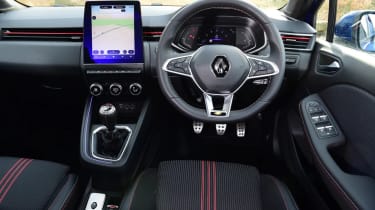
Rear seat space is still a bit tight for adults, but the trade off is a boot that's large for the class. At 391 litres with the back seats in place (366 for the diesel and 301 litres for the E-Tech), there's plenty of carrying capacity. Fold the rear bench and this figure jumps to 1,069 litres (1,054 for the diesel and 979-litres for the E-Tech).
Running costs
All Clios need to be serviced every 12 months or 18,000 miles. Services alternate between Minor and Major, which are effectively an inspection and then an oil and filter change. The two services are priced at £116 and £199 and they can be combined, but by the time a Clio has had its third birthday it's then eligible for cut-price maintenance. From this point on, more comprehensive services are offered, billed as Essential (at £129) and Full (£179).
The former is effectively an oil and filter change with an inspection; the latter includes a few extra replacement parts. Every three years or 72,000 miles the brake fluid has to be renewed (at £108), and while the engines don't have cambelts they do have auxiliary belts that need to be replaced every six years or 90,000 miles, at about £149. Incidentally, whereas the Clio Mk4 came with a three-year warranty with a 60,000-mile limit, its successor had a five-year guarantee that expired only at the 100,000-mile mark.
Recalls
Renault has recalled the Clio on just one occasion so far. In February 2020, 72 Clios built between June and October 2019 were recalled, because the power assistance could fail for the steering. The car would retain its steering, but it would suddenly get very heavy. Renault's solution was to fit a replacement steering column.
Driver Power owner satisfaction
Having made its debut in our 2020 Driver Power new car survey in an unimpressive 62nd place out of 75 entries, the Clio achieved a more encouraging 29th place in the 2021 poll. Clio owners were impressed with the quality of the fit and finish of their cars, the large boot and the responsiveness of the steering. Also in the pros column are the brakes, the ride quality, the fuel economy and the user-friendliness of the infotainment. Owners aren't so keen on the effectiveness of the heating and ventilation or the dashboard ergonomics, and there's room for improvement in terms of all-round visibility and interior storage space.
Opel Corsa celebrates 40 years with the launch of a special edition
The original Corsa A entered the scene in 1982, and to mark the 40th anniversary of its collection, Opel will launch a special edition in a certain retro "taste".
Namely, the German hatchback from the B segment is painted in "Record" red, which is a shade that adorned a distant ancestor from four decades ago. To provide an attractive two-tone look, the roof is black, while the "floating" theme is achieved by darkening the A and B pillars, as well as the upper part of the rear pillar.
Opel will sell the Corsa 40 Years with 17-inch wheels in a glossy black finish with matte accents. To further emphasize the two-tone exterior theme, the front grille and mirror trim come exclusively in black, as does the rear roof spoiler. The icing on the cake consists of 3 darkened badges.
When it comes to the interior, the Corsa 40 Years evokes an ancestor with tartan upholstery, which was a common solution in European cars of the eighties. To be completely "in shape" with retro seats, you can already buy socks of the same patterns, which are also produced in a limited series.
As for this edition of the Opel B-segment, each of the copies will receive a plate with an individual number, from 0001 to 1982. It is located on the passenger side of the dashboard on a black background with a red insert.
Being a special edition, the Corsa 40 Years comes "packed" with rich standard equipment, from automatic LED lights and Apple CarPlay / AndroidAuto connectivity, to safety systems such as head-on collision warning with automatic braking and pedestrian detection.
The best-selling car in Germany last month, when the Corsa was the most popular electric car, generated a total sales of 14 million units since its inception 40 years ago. Currently in its sixth generation, the sister model Peugeot 208 / e-208, in a special edition, will be on sale in the weeks ahead, in selected European markets.
Production of the Hyundai Veloster ends in July
According to South Korean Hankyung, Hyundai should stop production of the Veloster next month.
According to that report, Hyundai will completely abolish the name Veloster after 11 years, which means that this model will not get a successor.
The move is expected to boost Hyundai's next-generation Kona production, as well as the sale of the Elantra N, known as the Avante N in South Korea.
The news of the abolition of Veloster came after reports earlier this month that production of the original Ioniq would also be discontinued in July.
Hyundai currently produces exclusively Veloster N, and it is made in Hyundai's Ulsan 1 factory, where Kona is also assembled. With the arrival of the new generation of Kona next year, the abolition of Veloster should leave more space for the production of Kona.
Hankyung is also dealing with the sales ratio of the Elantra N compared to the Veloster N. The South Korean manufacturer has been selling fewer and fewer Veloster Ns since the introduction of the Elantra N, which is quite understandable because these two cars overlap in terms of performance.
What will the global car market look like in 2035 and what will happen to diesels?
It is estimated that electric cars and electric delivery vehicles will account for 45 percent of the market share in the world, and less than one percent will remain for vehicles with hydrogen fuel cells and diesels. The rest goes to hybrids and gas stations.
You already know that the intention of the European Union is to ban the sale of petrol and diesel cars and delivery vehicles on its territory in 2035. But how will it be in the rest of the world?
Is 2035 the moment when we will say goodbye to internal combustion engines globally? The answer is clear - no! At least that's what Boston Consulting Group (BCG), a reputable management and strategy consulting firm, predicts.
Thus, BCG announces that in 2035, 11 percent of gasoline will be sold in the world, followed by 43 percent of all types of hybrids (light, classic or plug-in) based on gasoline engines. Electric cars and electric vans will account for 45 percent of the market share, and less than one percent will remain for hydrogen fuel cell vehicles and diesels.
If you want to buy a new hybrid, petrol or diesel, you will have to move to parts of Asia, South America or Africa, or hope that Serbia will not join the European Union.
The Audi 80 is celebrating its 50th anniversary
The BMW M is not the only brand to celebrate its 50th anniversary this year, as the Audi 80 was introduced to the global market in 1972 during the Summer Olympics.
Codenamed B1, the Audi 80 is considered the originator of compact sedans or the B series. When it comes to the most important Audi models in history, the Audi 80 always has its place because of its contribution to the brand in terms of history and sales.
In addition to becoming a true classic, the Audi 80 and its successors have always brought innovation. These include a four-cylinder TDI engine, Quattro drive with self-locking center differential, DTC transmission and rear sports differential.
Of course, among the innovations are five-cylinder turbo engines like those in the first RS model, which show Audi's expertise.
The first Audi 80 was a lightweight two-door car weighing just 835 kg, designed to be fully compact, with a wheelbase of 2.47 meters and a total length of 4.18 meters. It was known for its handling and low fuel consumption, and in 1973 it won the award for the best European car of the year.
The Audi 80 was also a commercial hit, both in Europe and in the US where it was sold as the Fox. It became the first Audi model with more than a million units sold, and in combination with the successor to the A4, that number is more than 12.5 million units (from B1 to B9).

